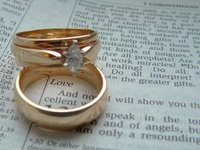With this ring I thee wed (I)
Leer en Español
 If somebody asked you about the meaning of your engagement ring you would probably answer that it is a symbol of love and commitment between two people. However, it has not always been this way. There are more myths and legends than actual facts around the engagement ring history, but I’m sure that among these you’ll find interesting stories and traditions.
If somebody asked you about the meaning of your engagement ring you would probably answer that it is a symbol of love and commitment between two people. However, it has not always been this way. There are more myths and legends than actual facts around the engagement ring history, but I’m sure that among these you’ll find interesting stories and traditions.
The pre-historic men tied the woman’s arms and legs together so she could not escape. Eventually the bride’s legs were released and if she didn’t attempt to run away she would just wear a tied cord with a trailing end around one of her fingers.
In the 2nd Century we find the first rings offered as an exchange of love and marriage. Some claim that they were made of iron and that the Ancient Romans were the first to engrave them; others confirm that it was a gold band that symbolized the everlasting love and commitment to marriage and that it was usually carved with two clasped hands.
I also found some interesting stories related with the Catholic Church that state that in 860 A.D. Pope Nicholas I decreed that an engagement ring should become a required statement of nuptial intent. The fact that they were made of gold signified a financial sacrifice on the part of the prospective husband. Some centuries later, in 1215 Pope Innocent III declared a longer waiting period between betrothal and marriage.
However, one of the few examples that records the tradition of giving a ring as a commitment of marriage dates of 1477 when Archduke Maximillian of Hamburg gave Mary of Burgundy a diamond ring. You can find a reproduction of the ring in the Kunsthistorisches Museum of Vienne. The diamonds were disposed as a gothic letter “M” that referred to Holy Mary and the eternal union of Mary and Maximillian. The Venetians popularized this custom in the 15th Century; because the diamond is the hardest and most enduring substance in nature —diamond means invincible in ancient Greek (adamas; Адамас) — they believed that the engagement marriage would endure forever. Less wealthy citizens gave a Fede (faith) ring shaped in the form of two clasped hands.
In the 18th Century diamond cluster engagement rings were fashionable among the wealthy. In South Africa 1870 the newly discovered Kimberley diamond region began to flood the market with diamonds, so the prices fell. At this time people thought that various birthstones were seen to be a rarity compared to diamonds and elaborated engagement rings of sapphire, emerald and rubies with diamond accents were more common among the wealthy people.
Within 10 years the now famous De Beers Consolidated Mines Ltd. was formed by the Englishman Cecil John Rhodes to control the sale of diamonds throughout the world. Even today they control 65% of the world’s diamond trade. From 1880 De Beers were able to control the supply (and price) of diamonds. But how were they going to control demand when sales began dropping dramatically onwards through the great depression?
The answer to the problem was a very clever marketing campaign commissioned by De Beers that began in 1947. The slogan "A Diamond is forever" marked the beginning of a change in the history of the engagement ring. Gentlemen Prefers Blondes with its theme Diamonds are a Girls Best Friend; High Society, Breakfast at Tiffany’s and Diamonds are Forever are a few among other examples that make us realize that after all, buying a diamond engagement ring isn’t really a popular ancient tradition.
Today, estimated 78% of all engagement rings sold every year are diamond. So trust me, she'll be expecting a diamond!
 If somebody asked you about the meaning of your engagement ring you would probably answer that it is a symbol of love and commitment between two people. However, it has not always been this way. There are more myths and legends than actual facts around the engagement ring history, but I’m sure that among these you’ll find interesting stories and traditions.
If somebody asked you about the meaning of your engagement ring you would probably answer that it is a symbol of love and commitment between two people. However, it has not always been this way. There are more myths and legends than actual facts around the engagement ring history, but I’m sure that among these you’ll find interesting stories and traditions.The pre-historic men tied the woman’s arms and legs together so she could not escape. Eventually the bride’s legs were released and if she didn’t attempt to run away she would just wear a tied cord with a trailing end around one of her fingers.
In the 2nd Century we find the first rings offered as an exchange of love and marriage. Some claim that they were made of iron and that the Ancient Romans were the first to engrave them; others confirm that it was a gold band that symbolized the everlasting love and commitment to marriage and that it was usually carved with two clasped hands.
I also found some interesting stories related with the Catholic Church that state that in 860 A.D. Pope Nicholas I decreed that an engagement ring should become a required statement of nuptial intent. The fact that they were made of gold signified a financial sacrifice on the part of the prospective husband. Some centuries later, in 1215 Pope Innocent III declared a longer waiting period between betrothal and marriage.
However, one of the few examples that records the tradition of giving a ring as a commitment of marriage dates of 1477 when Archduke Maximillian of Hamburg gave Mary of Burgundy a diamond ring. You can find a reproduction of the ring in the Kunsthistorisches Museum of Vienne. The diamonds were disposed as a gothic letter “M” that referred to Holy Mary and the eternal union of Mary and Maximillian. The Venetians popularized this custom in the 15th Century; because the diamond is the hardest and most enduring substance in nature —diamond means invincible in ancient Greek (adamas; Адамас) — they believed that the engagement marriage would endure forever. Less wealthy citizens gave a Fede (faith) ring shaped in the form of two clasped hands.
In the 18th Century diamond cluster engagement rings were fashionable among the wealthy. In South Africa 1870 the newly discovered Kimberley diamond region began to flood the market with diamonds, so the prices fell. At this time people thought that various birthstones were seen to be a rarity compared to diamonds and elaborated engagement rings of sapphire, emerald and rubies with diamond accents were more common among the wealthy people.
Within 10 years the now famous De Beers Consolidated Mines Ltd. was formed by the Englishman Cecil John Rhodes to control the sale of diamonds throughout the world. Even today they control 65% of the world’s diamond trade. From 1880 De Beers were able to control the supply (and price) of diamonds. But how were they going to control demand when sales began dropping dramatically onwards through the great depression?
The answer to the problem was a very clever marketing campaign commissioned by De Beers that began in 1947. The slogan "A Diamond is forever" marked the beginning of a change in the history of the engagement ring. Gentlemen Prefers Blondes with its theme Diamonds are a Girls Best Friend; High Society, Breakfast at Tiffany’s and Diamonds are Forever are a few among other examples that make us realize that after all, buying a diamond engagement ring isn’t really a popular ancient tradition.
Today, estimated 78% of all engagement rings sold every year are diamond. So trust me, she'll be expecting a diamond!

0 Comments:
Post a Comment
<< Home